Tracing a golden legacy
From:CHINA DAILYAuthor: 2024-02-27 10:20
A Beijing handicraft factory is carrying forward tradition and innovation, giving new mettle to old metal with designs that shine across time, Chen Nan reports.
Editor's note: Traditional arts and crafts are supreme samples of Chinese cultural heritage. China Daily is running this series to show how master artisans are using dedication and innovation to inject new life into these age-old heritages. In this installment, we examine how the ancient craft of cloisonne reflects our modern lives.
You'll see large cloisonne vases, striking plates and other colorful pieces in Beijing Gongmei Group's arts-and-crafts factory's studio near Yonghegong, or the Lama Temple, in the capital.
Gaze upon these long enough, and you will be stunned by the diversity of distinctive Chinese patterns traced by countless thin golden wires.
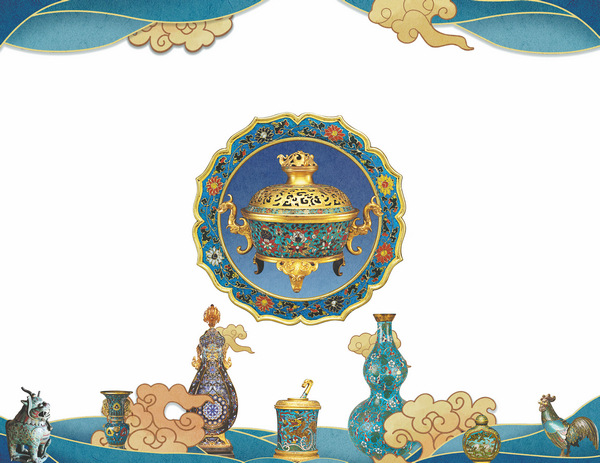
Items in the collections of Beijing's Palace Museum and New York's Metropolitan Museum of Art offer a source of inspiration for modern cloisonne artworks. JIANG DONG/WANG KAIHAO/CHINA DAILY
"It's said that there are 108 steps in the process of producing cloisonne goods," says the factory's director, 59-year-old Zhang Yongzhen, who has practiced the craft for four decades.
"I don't know the exact number. But I can tell you that the traditional handicraft is very sophisticated. No one can finish the whole process by himself or herself. It's a delicate art that takes dedication to every small step."
Cloisonne, or jingtailan in Chinese, is the technique of creating designs on metal with colored-glass paste, or enamel, that fills in spaces among copper or bronze wiring that's bent or hammered into patterns.
The fundamentals include shaping the object's body; bending and inlaying copper wires to render surface patterns; coloring in the shapes these wires form with metallic oxides; heating — since the enamel usually shrinks after firing, this process is repeated to fully fill in the designs — and, finally, polishing and gilding.
The technique was introduced to China in the late 13th century. It's believed that cloisonne reached its peak and was given its present Chinese name during the reign of Emperor Jingtai in the Ming Dynasty (1368-1644). Lan means blue in Chinese, and jingtailan goods were typically infused with a special dark blue enamel as the base color.
The craft was further developed in the Qing Dynasty (1644-1911), following innovations in copper-smelting techniques.
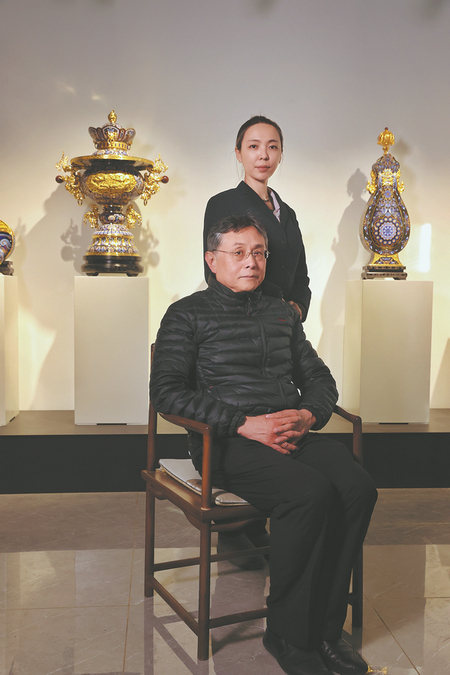
Zhang Yongzhen and his apprentice Xi Wen are two master artisans of cloisonne at the Beijing Gongmei Group.JIANG DONG/CHINA DAILY
Future relics
Zhang calls cloisonne goods "treasures that will be seen as cultural relics 1,000 years later".
"Cloisonne, with its flamboyant styles and vibrant colors, was initially primarily intended for the royal family. The objects' bodies were usually made of copper or bronze, which were expensive materials that could only be owned by royal families in the past," Zhang explains.
He adds that jingtailan is one of the Yanjing Eight Palace Handicrafts, which also include embroidery, and jade and ivory carving. (Yanjing is an old name for Beijing.)
Zhang says he didn't realize these treasures' value when he began to learn cloisonne at around age 17, when his father sent him to a vocational school to study the technique. His dad spent his whole life working on the first step of making cloisonne items — hammering copper or bronze into the objects' shapes.
Zhang instead learned the more intricate step of using thin metal wires to outline patterns and designs on the surfaces.
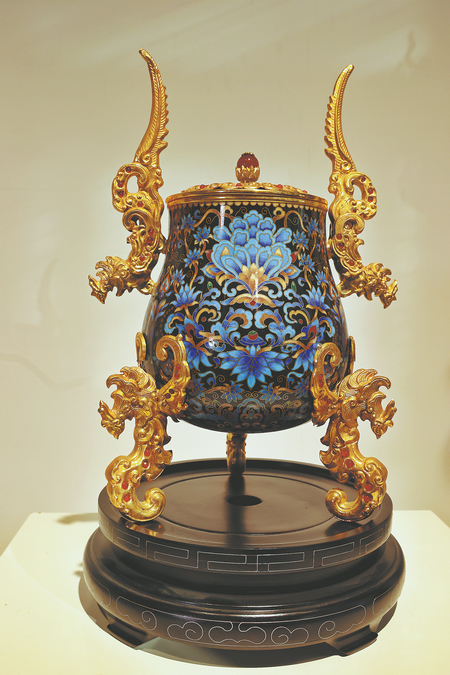
Zhang Yongzhen and Xi Wen's creations of cloisonne vessels feature traditional patterns and are inspired by ancient bronze ware. JIANG DONG/CHINA DAILY
"There were about 30 students in the class, among them only three men," Zhang recalls.
"The technique requires patience and concentration. Imagine inserting the thin metal wires with small tweezers and repeating the movements thousands of times every day. It was very boring.
"But I still agreed to learn it and later worked at the same factory as my father since he believed the job was stable and guaranteed my livelihood. I listened to him."
Still, Zhang continued to seek other jobs in different departments of the company. He even worked abroad as a salesman, and as a trainer and manager at the factory.
"When I saw people were wowed by the technique, especially when I worked abroad, I started to rethink cloisonne. I didn't realize its beauty and value until I left it and observed it as an outsider," Zhang says.
"Now, I still love watching people in the factory making cloisonne, from the very beginning of designing the products to the final stage of polishing."
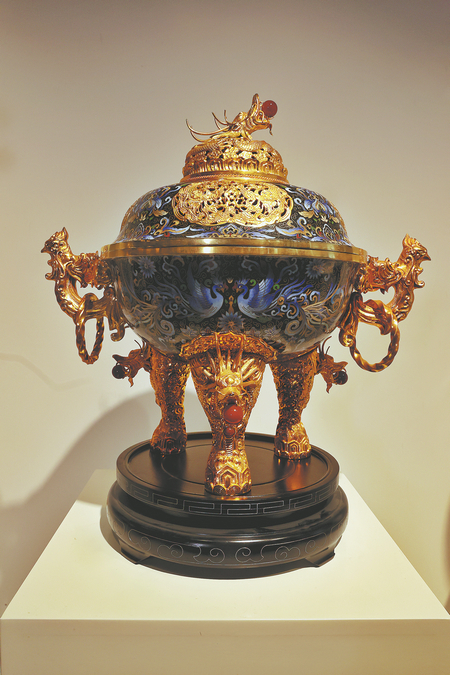
Zhang Yongzhen and Xi Wen's creations of cloisonne vessels feature traditional patterns and are inspired by ancient bronze ware. JIANG DONG/CHINA DAILY
Creative creations
New blood is needed to infuse the old medium, Zhang explains.
He particularly praises 39-year-old Xi Wen, head of the design department of the factory, which belongs to the 70-year-old Beijing Gongmei Group.
She joined the group in 2007 after graduating from the Academy of Arts and Design of Tsinghua University as an environmental art design major in 2007. Later, she obtained a Master of Arts in interior design from the Central Academy of Fine Arts. Her cloisonne designs have since won national awards.
"I first learned about the technique when I was a student," the Beijing native recalls. "The beautiful photos of cloisonne appeared in my school books and intrigued me."
Xi's mother was a fan of Chinese paintings and had her study traditional painting and calligraphy at around age 4. She sensed the girl's talent and encouraged her to pursue art as her career.
"My mother told me that I could paint very detailed features of an object, such as the small black dots on a yellow pear. She believed that I could become a great painter because of my 'observant eyes' and sensitivity to color," says Xi.
Xi worked as a designer with the Beijing Gongmei Group for years before she was transferred to the arts-and-crafts factory in 2016. Since then, she has concentrated on learning cloisonne techniques and designing related products as Zhang's apprentice.
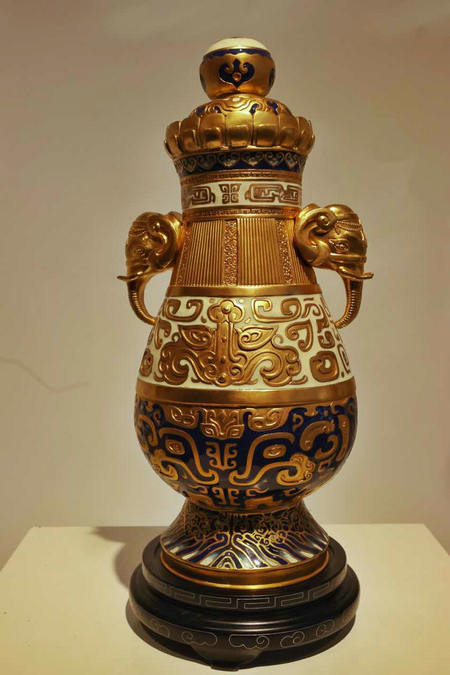
Zhang Yongzhen and Xi Wen's creations of cloisonne vessels feature traditional patterns and are inspired by ancient bronze ware. JIANG DONG/CHINA DAILY
"When I was a designer, before learning with Zhang, I only painted on paper. Now, my paintings not only appear on paper but also come alive as real objects. That makes me very happy and proud," says Xi.
"I've never found learning cloisonne boring because, to me, it's a magical process to turn a piece of metal into a piece of art. I used to spend the whole night watching the colors change during the firing process."
Zhang says: "Unlike traditional cloisonne artisans, who strictly follow their masters' instructions, Xi is full of creativity and imagination when it comes to design. She is also very bold with the use of colors. Her creations are unique."
One item Xi made was inspired by a pipa (a traditional Chinese lute) that's depicted in the murals of the Mogao Caves, a UNESCO World Heritage Site in Northwest China's Gansu province.
Named Shengshi Hefeng, or Prosperity and Harmony, the black, blue and gold vase, which resembles the pear-shaped instrument, combines the traditional techniques of cloisonne and filigree inlay.
Xi also made a pair of items named Dragon and Phoenix that combine cloisonne with carved lacquer, which is also one of the Yanjing Eight Palace Handicrafts.
She hopes to bring jingtailan into people's daily lives by making everyday items like jewelry, boxes and incense burners.
"I don't consider myself an artist, although I design and paint. I like the word artisan, which is not only about the creative side but also about functional value," Xi says.
"Artisans make cloisonne products with their hands and — through skill, experience and talent — they can create things of great beauty that are also useful."
Edit:董丽娜
The copyright of the article and the picture belongs to the original author. If there is any infringement, please contact to delete it